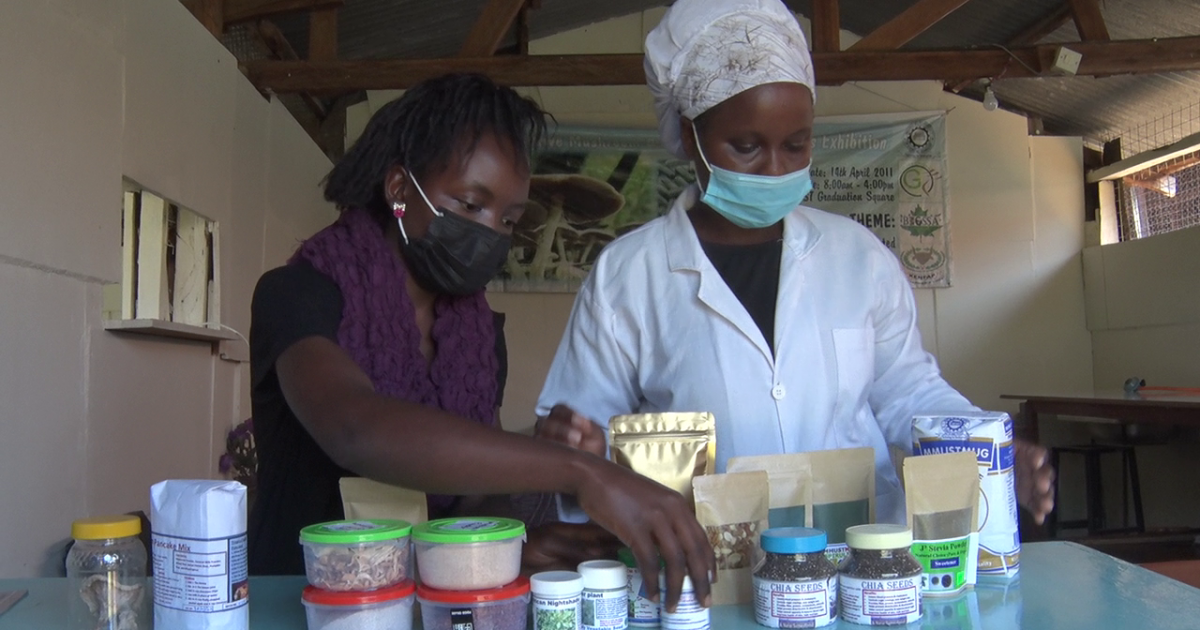Masinde Muliro University of Science and Technology (MMUST) is set to introduce into the market porridge flour produced from mushrooms at the University’s Mushroom and Spirulina research project lab.
The porridge flour with an acronym MMUSTMUG also contains a mixture of millet and sweet potato powder.
The University’s lecturer in charge of Nutrition Sciences, Prof Asenath Sigot, said the de

partment has done sufficient research about the mushroom flour which has turned out to be successful and will be introduced in the market once they scale up production.
Currently, production at the lab is still low, due to lack of enough raw materials. The lab is located at the Milimani section of the University, off the administration block, where grinding, mixing and packaging of the MMUSTMUG is done.
“We now have porridge flour, which we call MMUSTMUG which contains mushroom, millet and sweet potatoes. This is a product that we are hoping to commercialise. We have done sufficient research at the university and we know it is very successful,” she noted.
Prof Sigot encouraged Kenyans to drink porridge cooked from the flour which is rich in thiamin, fiber, which is low in fat, sodium free, a good source of iron, and it is high in vitamin A.
Mushrooms alone are rich in sodium, calcium, phosphorus and potassium and have low cholesterol levels.
At the same time, Professor Sigot, asked farmers to uptake production of mushrooms which they can consume locally and if need be, supply to the institution for processing into flour or they can still use the mushrooms for their own consumption.
She said mushrooms can be grown in a small space of land and can be harvested four times in a year.
“Mushrooms do not need much space. They require small spaces and you can keep growing them throughout the year. It is not like maize where you grow once or twice in a year,” she pointed out.
Prof Sigot noted that in the era of food security, mushroom farming should be adopted by farmers and even county governments are encouraged to support those willing to venture into the enterprise.
She noted that the University, through the department of nutrition sciences, has engaged 10 farmers through support in disseminating latest farming techniques in mushroom farming in Lurambi Sub County of Kakamega County and in Vihiga.
“We have so far engaged 10 farmers, whom we trained and who have since gone to train others. We occasionally visit them and hold field days to share their ideas of growing mushrooms with other farmers,” she pointed out.
According to Professor Sigot, mushrooms have medicinal values and can be consumed as vegetables, in porridge, in soup and in other food products.
She noted that the University will support those willing to venture into mushroom farming by ensuring they get the latest technologies and skills needed in producing the crops within a small space.
“The support we are giving to farmers is by availing to them of the technology of growing mushrooms. You know, for a long time, mushrooms were being grown in plastic bags. So we want to introduce new ways of growing mushrooms,” she noted.
She says Sh50 000 is enough for a farmer to set up a structure and get materials needed to start producing mushrooms in a small space of land.
“We are now trying to integrate mushrooms with other crops in our community like I have a student currently integrating mushroom cultivation with bananas, because most homes have bananas, so she is trying to say, why don’t we intercrop mushrooms with bananas,” she added.
The Professor noted that the only challenge which they have is production of spawns, where mushroom grows from. Spawns are like seeds in other crops.
The spawns are then transferred to substrates, which are substances where mushrooms grow. Substrates commonly available are maize stocks and sugar bagasse among others.
“After the mushroom spawns have been obtained, they are mixed with substrate such as maize cobs, sugar bagasse and other common wastes where they grow from,” Prof Sigot explained.
She says producing spawns from which mushrooms grow is a delicate process that is done through tissue culture process. The only institution that produces spawns according to Professor Sigot is the Jomo Kenyatta University of Agriculture and Technology (JKUAT).
“At the same time, we are introducing mushroom farming since most of the agricultural waste can be converted into a substrate for growing the mushrooms, so you don’t throw away when you pick up the maize stalks, maize cobs, all of that can be used to make the substrate for growing the mushrooms,” she noted.
Currently, Professor Sigot said the University has not succeeded in building synergies with other organisations or stakeholders but has managed to partner with community members who have been trained and are actively using the skills to disseminate information to other willing farmers.
One of the farmers who has ventured into mushroom farming in Kakamega, Daniel Shikote, said since he started producing mushrooms in 2020, he has never looked back.
Shikote owns a mushroom farm known as Shidans Green Farm located at Bukhaywa in Isukha North, Shinyalu Constituency. He said that from his experience as a mushroom farmer, button mushrooms are consumed much in Kenya but that Oyster mushrooms are easier to plant unlike button mushrooms which are labour intensive.
Shikote however said that one needs to have knowledge and skills to produce mushrooms which are very delicate as he promised to disseminate knowledge and skills to those willing to start.
The common challenge is getting substrates for him. He uses sugar bagasse or maize stocks as substrates mixed with molasses and sawdust.
He cautioned that use of maize stalks which are not well dried can lead to molds which may contaminate the resulting mushrooms.
Other raw materials to use are wheat straw and rice straw of which he says are expensive since they are not easy to get. He said that as mushroom farmers, they lack knowledge to produce quality spawns where mushrooms grow.
By Moses Wekesa and Margaret Andeso





